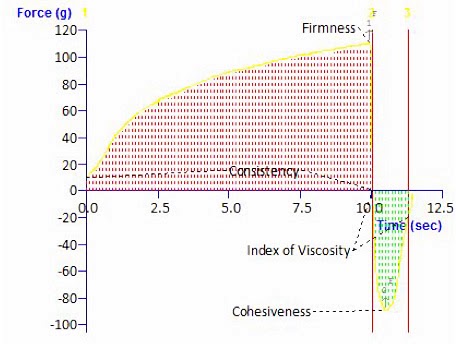 FIRMNESS/HARDNESS/SOFTNESS are textural properties that are on the same general property spectrum.
FIRMNESS/HARDNESS/SOFTNESS are textural properties that are on the same general property spectrum. A soft product is one that displays a slight resistance to deformation, a firm product is moderately resistant to deformation, while hardness describes a product which shows substantial resistance to deformation.
However, it is also likely that, depending upon the particular industry, one of these words may be more favourable or pertinent to a specific product.
The terms Firmness, Hardness and Softness are so broadly used that they can be obtained by a variety of different test types. In certain cases, the product may have limitations in presenting to the texture analyser for testing. For these reasons, a compromise solution may have to be found to optimise the testing of the required product property.
 The test type is chosen according to the size, form, homogeneity etc. of the sample and can therefore be derived from a single piece compression, bulk compression, penetration, extrusion or cutting tests as is most appropriate. Whilst performing one of these tests, it is not uncommon to be able to obtain a number of other textural parameters that are also possessed by the product.
The test type is chosen according to the size, form, homogeneity etc. of the sample and can therefore be derived from a single piece compression, bulk compression, penetration, extrusion or cutting tests as is most appropriate. Whilst performing one of these tests, it is not uncommon to be able to obtain a number of other textural parameters that are also possessed by the product.
Related properties:
SPREADABILITY
BITING FORCE/CUTTING FORCE
CONSISTENCY
RUPTURE FORCE
COMPACTION FORCE/COMPRESSIBILITY
TOUGHNESS
Whilst Firmness/Hardness/Softness is a descriptive term that has no standard scientific definition in Texture Analysis it is conventionally accepted as being either the force at the maximum distance of a compression cycle (e.g. puncture test on butter) or the maximum force reached prior to a fracture (eg biscuit break or puncture through skin of an apple). Hardness can also be the force required to deform a product to a given distance.
However, firmness can only be compared at the same distance of compression/penetration. Sometimes the maximum force may not be the most reproducible section of the curve (especially if this is the point at which a rupture occurs, for instance in a gel penetration test). The force at a chosen earlier distance before rupture may then be taken as a more repeatable representation of firmness.
Typical Methods & Fixtures for Firmness/Hardness/Softness Measurement in action:
Typical physical properties that can be obtained from a texture analysis graph:
Firmness, softness, hardness, toughness, springiness, break force, ripeness, skin strength, bioyield force, work of penetration, work of extrusion, stickiness.
A wide range of attachments is available for measuring texture analysis properties.
 |
| Typical Texture Analyser graph with annotated properties |
We can of course design and manufacture probes or fixtures for the TA.XTplus texture analyser that are bespoke to your sample and its specific measurement.
Once your measurement is performed our expertise in its graphical interpretation is unparalleled – no-one understands texture analysis like we do. Not only can we develop the most suitable and accurate method for the testing of your sample but we can prepare analysis procedures that obtain the desired parameters from your curve and drop them into a spreadsheet or report designed around your requirements.
For more information on how to measure texture, please visit the Texture Analysis Properties section on our website.
To discuss your specific test requirements click here...
 |  |  |

No comments:
Post a Comment